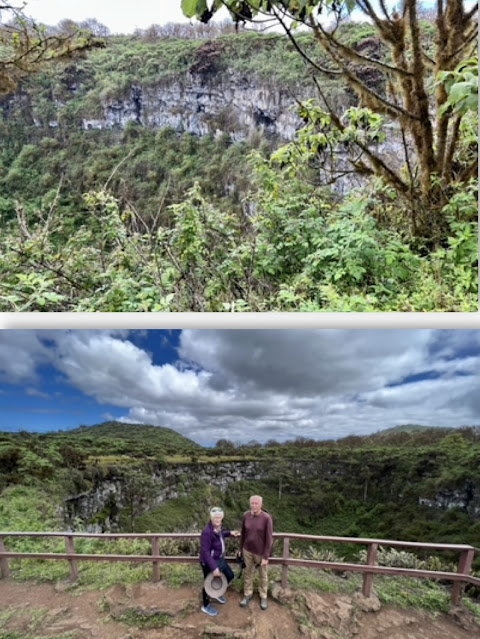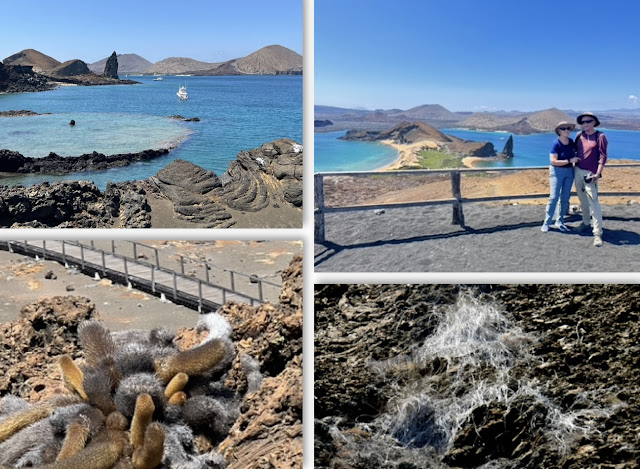Up early and off to the airport for the flight to Baltra in the Galapagos. We were greeted at the airport by a snowman and then welcomed at the VIP lounge where we met a honeymoon couple who were coming from the Mashpi Cloud Forest (our next destination) and had enthusiastic reports.
On our way to the camp, we first stopped to see "twin" sinkholes made from collapsed lava tubes. In the parking lot we were greeted by a mock "little vermilion flycatcher". Students were there to raise awareness of the plight of these small birds, the population of which is declining at a rapid rate, due to the change in land use on the inhabited islands.
We next stopped at the El Chato Ranch to visit with the Giant Land Tortoises (not turtles). We learned that a combination of tortoise's size and the markings on it's shell indicate the age. The more distinct the markings, the younger the tortoise. The bigger ones, around 1.5 meters, could be around 100 years old. And they cool themselves off by wallowing in the mud.
We also explored a lava tube and then enjoyed a simple, tasty lunch in the Ranch dining room. Notice the "crackers" in the squash soup. Yep, popcorn is popular in soups in Ecuador.
We then continued on the the Camp. Once we had settled in we went to the Viewpoint for drinks and to watch the sunset. Dinner was basically a wine & food pairing, as were all the following dinners. Each meal was documented on a chalk board and there were suggested wines pairings. Of course we sampled all of the pairings and with one exception they were great.
Other notices were also posted daily on "chalkboards" including the day's adventure and a bedtime note.
On our first day of explorations, we were off to Tortuga Bay where we walked along a paved walk out to the bay. Our guide recalled trekking to the bay backin the days before the paved walk. What now takes 45 minutes or so, used to take 3 hours. Along the walkway are verrrrry tall and old Nopal like cactus. And lots of marine iguanas lounge on the beach. During our kayak paddle we saw: white & black tipped sharks, rays, sea turtles, blue footed boobies, a marine iguana swimming in the bay, a sea lion, and a baby hammer head shark.
 |
| Us with blue footed boobies; marine iguana swimming; brown pelican; marine iguanas on the beach; us in front of the local version of a prickly pear (nopal) cactus; blue footed booby. |
Next morning we were up early for our first cruise, a trip to North Seymour Island. After a 45 minute ride we toured the island and got views of sea lions, frigate birds (the male is noted for it's red pouch), boobies, and both land and marine iguanas.
 |
| Swallow tailed gulls (and their egg); frigate birds (in flight and nesting); land iguana; marine iguana. |
Our second boat trip was to Bartolomé Island, a 2 plus hour cruise. From the base of the island we climbed roughly 400 steps for an amazing view. Along the way we passed some cacti and a primitive plant that is the first growth after an eruption.
On our way to breakfast the next day, we saw a young tortoise just off our deck. When we returned it was sparring with another tortoise. The young one appeared to be trespassing on an elder's territory.
On our final day we went to Trapiche Farm which produces coffee, chocolate, sugar, and Moonshine.
 |
| Pressing the sugar cane; heating up the still; testing the alcohol; roasting the coffee beans. |
We were impressed with the skyline of giant cacti.
Another seafood lunch, this time at Isla Restaurante and then a tour of the Darwin Center where they raise tortoises from the different islands, trying to preserve variants of each species. Here we were introduced to tortoises with longer necks than we had previously seen. The ones with short neck forage on the ground. The one with long necks dine on the shrubbery.
Lonesome George (seen below with Pat), lived from 1910 to 2012, he was the last of the Pinta Island strain.
We later checked out the shops in town. Nice, but not exceptional.















No comments:
Post a Comment